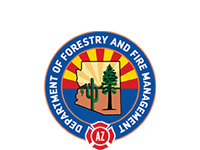Disease
Foliage Diseases
Foliage diseases are most commonly seen in Arizona on aspen, Arizona sycamore, oak, cottonwood and willow. Individual trees or whole groups can become infected when favorable moisture conditions occur. Heavy infections can cause partial or complete defoliation of infected trees, reducing growth and causing scattered dieback of twigs and branches. Black leaf spot, Melampsora rust, oak and sycamore anthracnose are the most common species identified.
On conifers, foliage diseases are less common but may be very dramatic when they occur, causing infected needles to discolor and fall off. The most common conifer needle diseases include Elytroderma needle cast and Red band needle blight of ponderosa and pinyon pine, and Rhabdocline needle cast of Douglas-fir.
Stem and Trunk Decay
Decay of wood is caused by fungi that infect both living heartwood and dead wood and sometimes both. Decay fungi also serve a critical role in nature recycling nutrients back into the soil for utilization by other organism. Most decay fungi of live trees do not kill infected trees but may structurally weaken the branch or trunk, causing wind breakage and windthrow. This is usually correlated with the age of the tree and the extent of the decay. Hardwoods including aspens and cottonwoods are highly susceptible to stem and trunk decay.
Conifers including Douglas-fir, white-fir and spruce are generally more susceptible mainly due to the wetter and cooler environments they inhabit. Conversely pines are less susceptible due to the warmer and drier habitats in which they occur.
Common decays found on hardwoods include false tinder conk on aspen, which produce conspicuous hoof-shaped conks or fruiting bodies clearly visible on the trunk. Very dramatic and large fruiting bodies of sulfur-shelf fungus can be seen on oaks and poplars, and heart rots and canker rot of oaks and New Mexican Locust is fairly common.
On conifers, multiple fruiting bodies or conks of red ring rot can be detected on the trunk of infected Douglas-firs and pines. Red belt fungus also produces shelf-like perennial conks which feature a red-brown band above a light-colored base on dead conifers.
Cankers
Localized areas of dead bark and underlying wood on twigs, branches and trunks caused by fungi are called cankers. They are usually a response to injury and are usually found on hardwoods. Aspen is the most common host of these diseases because of their soft bark tissue but also alders and cottonwoods.
Cankers seen on aspen include Black, Cryptosphaeria, Cytospora, Hypoxylon and Sooty Bark which is considered the most damaging.
Cankers are less common on conifers and Atropellis canker has been identified on limber, ponderosa and SW white pine.
Stem Rusts
Some stem rust fungus can have a complex multispecies lifecycle and others can complete their life cycle on only one host. Rusts can cause brooms, galls, flagged and swollen branches, trunk dieback, and mortality of conifers.
The most notable and destructive stem rust recently identified in Arizona is the non-native white pine blister rust. Comandra blister rust a native species has also been identified in the past on a non-native pine, Pinus eldarica. Other species include Limb rust, Western Gall rust, Fir and Spruce broom rusts and Gymnosporangium rusts on Arizona cypress and junipers.
Root Disease
Generally root diseases decay and kill roots, heartwood and sapwood of both conifers and hardwoods. Severity varies depending on root disease species, age of host and growing site history. Principal symptoms include yellowing of the leaves/needles, shortened terminal growth, reduced needle length, progressive thinning of foliage, fading crown, and reduced tree growth.
Tree species in Arizona susceptible to root disease fungi include aspen, oak, Douglas-fir, ponderosa pine, fir and spruce.
Prominent root diseases include Armillaria, Annosus, Ganoderma and Velvet Top fungus. Secondarily, bark beetles may infest trees heavily infected by root diseases.


